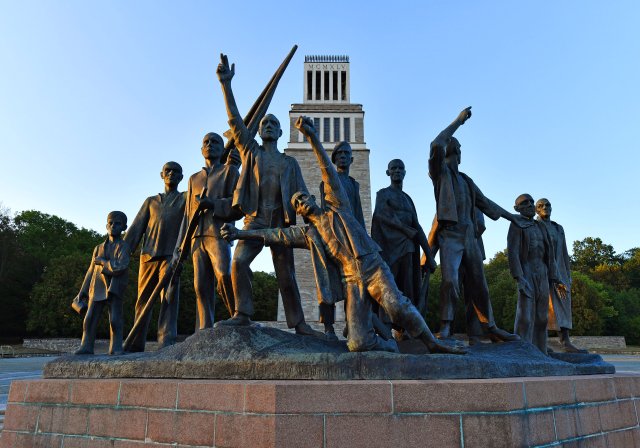Buchenwald’s warning: Never again fascism!
Photo: dpa/Martin Schutt
The Thuringian CDU announces: “We want to make Thuringia a model state again!” And: “We are keen on the future, on new beginnings and renewal.” Cheap formulations, to be sure. But what do they actually mean?
History does not repeat itself and yet often shows parallels. In the early 1920s, Thuringia, like Saxony, was a democratic-republican country, valued by many people as a beacon of hope that sought democratic rights and socio-political justice for all Thuringians through the implementation of a revolutionary imperial constitution. A left-wing reform project that was also serious about fending off the onslaught of reactionaries of all kinds.
Democratic politics, social justice and the creation of conditions that promote peace after the horrific First World War, combined with the humanistic “Spirit of Weimar” against the unresolved “Spirit of Potsdam”, these were the guiding principles of the government under the Social Democrat August Frölich. He, sometimes referred to as a left-wing socialist, embodied the left-wing reform project like no other. He was often characterized as a guy with a pure character, as someone who always strived to find peaceful, non-violent solutions to conflicts.
Frölich’s government was elected in September 1921 by 339,275 Thuringians. The election was close; the other parties only received 1,768 fewer votes. These others were primarily the Thuringian Landbund (TLB), the German People’s Party (DVP), the German National People’s Party (DNVP) and the German Democratic Party (DDP). With their 26 representatives, they represented a minority, but one that from the outset and with all the means at its disposal opposed any attempt to implement anything new. Both workers’ parties were downright hated by them. People lived in memories of the supposedly good old days, the end of which was believed to have been brought about by a cowardly stab in the back of the army by the left.
There was angry criticism from their ranks: the government was ruining the economy, there was “parliamentary absolutism” and “party dictatorship,” and “unnecessary bureaucratic institutions” were being created. The latter, to give just one example, was directed against the establishment of a Thuringian state employment agency planned for January 1, 1922.
The attempt to create larger economic and administrative areas, an essential prerequisite for a country that needs to be modernized and efficient, was criticized and also inhibited. The educational policy reforms that were supposed to abolish the conservative school system and replace it with a uniform school in order to finally offer equal educational opportunities at all levels to “all children of the people” were completely rejected. Basically, the bourgeois parties wanted to re-enforce the old educational privilege.
For the conservatives, the focus was on acting against the left. Right-wing and right-wing extremist forces can almost always rely on each other.
–
The conservatives also targeted every attempt to alleviate the social disadvantages that resulted from war and inflation for workers, farmers, war invalids, widows, orphans as well as small business people, craftsmen and employees. From their point of view, instead of ensuring social justice, individual social assistance should be granted. The promotion of art and culture was also not very popular, and it was not just about the well-known Bauhaus, but also about Thuringian adult education centers.
Prime Minister Frölich was, above all, one of the worst enemies of the emerging fascists. On November 9, 1923, he declared in a state parliament session: “If the Hitler Guards now come to Thuringia (…) to destroy the Novemberlings, because that is the purpose of the Hitler Guards, should we just keep quiet? I agree with the communists that we have to fight side by side to get this rabble out of Thuringia.” It was from this spirit that a Thuringian workers’ government was formed, formed by the SPD and KPD, basically following the example of the one on September 11th October 1923 in Saxony. Both are ended violently by the invasion of the Reichswehr. (For those interested, we recommend Mario Hesselbarth’s new book, “The Workers’ Government in Thuringia 1923”, published by the Thuringian Rosa-Luxemburg-Stiftung.)
The left-wing parties went into the 1924 election campaign in Thuringia badly weakened, among other things by the KPD ban issued by the Reich government after the “German October”, but above all again divided and more concerned with mutual accusations, including with regard to who was to blame for the rash actions End of the two workers’ governments. The bourgeois parties, on the other hand, acted more decisively and unified. They knew how to pool their strengths organizationally.
At the end of 1923, an “anti-socialist citizens’ and farmers’ alliance” emerged that was prepared to sacrifice even its “last button” against the left. It is probably not by chance that the term “order” was chosen for the electoral alliance. The Thuringian Order Association (TOB) came out with the slander of a country that had allegedly “gone to the dogs”. That should mean: Socialists cannot govern, let alone run a business. People remained silent about where the causes of inflation, economic crisis and other restrictions on everyday life really lay. The CDU is advertising today: “Thuringia is being left behind.” This again contains the accusation that leftists are incapable of governing and managing. And “order” must be created.
The anti-socialist threat and hate propaganda that was carried out early and constantly gave rise to a political concept that was ultimately disastrous even for the conservatives. It behaved as “anti-Marxist” even to this point, but also turned against democracy and the republic and did not shy away from taking a nationalistic approach. to serve racist and openly fascist forces. One could speak of a mixtum compositum in which anti-Marxism, i.e. anti-socialism and anti-communism, as well as hostility to democracy and the republic, Germanism and a strongly anti-Semitic racism were closely linked.
nd.DieWoche – our weekly newsletter

With our weekly newsletter nd.DieWoche look at the most important topics of the week and read them Highlights our Saturday edition on Friday. Get your free subscription here.
The election campaign took place at a time of upheaval, the causes of which were incomprehensible to a large majority of voters. Even after the end of hyperinflation, which had never been experienced before, many felt that their livelihoods were immediately threatened. There was a fall in prices for agricultural products. People in rural areas called for more state support and criticized that given to industry. Anti-inflationary measures had achieved nothing. Many social problems could not be solved.
All the more remarkable was the high voter turnout on February 10, 1924 of 89.6 percent compared to 72.4 in the state elections in 1921. The SPD won 23.1 percent of the vote and 17 seats. The KPD achieved 18.4 percent and 13 mandates, the USPD also achieved nine mandates with 0.8. The SPD and KPD together had 30 members in the new state parliament.
The TOB was able to win over half of the votes, which led to 35 mandates. That was a majority, but not an absolute one as hoped. 9.3 percent of voters voted for the United Völkische List (VVL), in which competing ethnic and Nazi groups had come together in order to be able to circumvent the bans on the German National Freedom Party and the NSDAP that had been issued in the fall of 1923. And for the first time, seven right-wing extremists entered a German state parliament.
The new state government was quickly formed. It was headed by the DVP politician Richard Leutheußer, who, by the way, was said to have been a downright misogynist. The new state government mostly acted on the basis of emergency laws and regulations, i.e. bypassing parliament. Within a short time, the school reforms were repealed and the ban on the NSDAP was reversed – without waiting to see how the trial against Hitler and other putschists in Munich would turn out. The Thuringian conservatives even agreed to clearly anti-Semitic actions, as shown by the affair surrounding the president of the Thuringian State Bank, Walter Loeb – he was dismissed because it was not only the ethnic people who were of the opinion that a Jew could not be tolerated at the head of a German banking institution.
Hitler had no reason to hope that Thuringia, “as things stand, could become the National Socialist stronghold of Germany.” It is not surprising that Wilhelm Frick was the first Nazi minister in a German country. This was followed in August 1932 by the almost pure Nazi government under Fritz Sauckel.
The Leutheußer government was not dependent on ethnic and Nazis. She had in no way had to fear that they might vote with the opposition; Their often and openly propagated “anti-Marxism” spoke against this. Of course, the completely negative attitude of the SPD and KPD towards the ethnic and fascists also spoke against this. At that time, however, the focus for the conservatives was on acting against the left. And right-wing and right-wing extremist forces could and can almost always rely on each other.
Prof. Dr. Manfred Weißbecker recently gave a detailed lecture on the subject in Jena, which can be read in the January issue of “Contributions to the History of the Labor Movement” (BZG).
Subscribe to the “nd”

Being left is complicated.
We keep track!
With our digital promotional subscription you can read all issues of »nd« digitally (nd.App or nd.Epaper) for little money at home or on the go.
Subscribe now!
judi bola link sbobet link sbobet link slot demo
